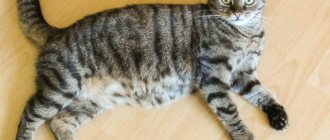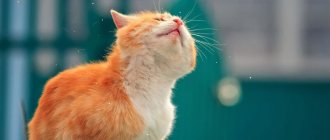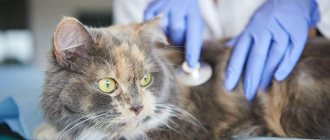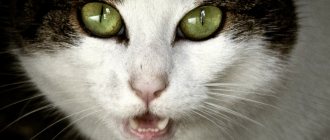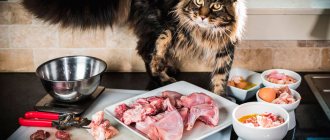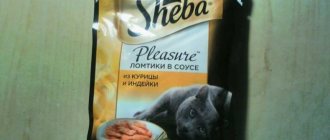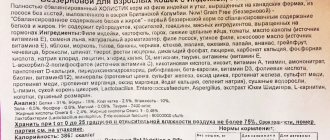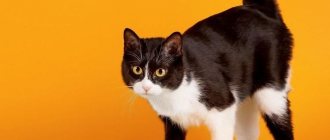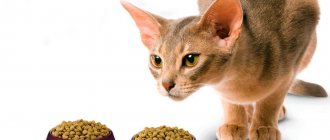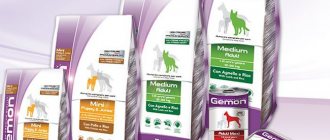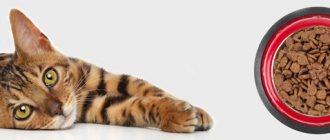Best Cat Foods for Weight Gain
When deciding what food to feed a cat to gain weight, the first thing people usually pay attention to is dry food. They are convenient to dose, have a long shelf life, are usually liked by animals and contain a full range of essential substances. The best dry food includes:
- Royal Canin Gastro Intestinal Moderate Calorie
- Hill's Science Plan Perfect Weight
- Acana Orijen SIX FISH
Royal Canin Gastro Intestinal Moderate Calorie
The food contains a daily dose of nutrients necessary for a cat’s health and is often prescribed by veterinarians for weight gain. This product is a special diet for cats with digestive disorders.
The composition includes LIP proteins, which are perfectly absorbed by cats. As well as prebiotics, beet pulp, rice, fish oil. There is an opinion that this food is intended for animals prone to obesity, but in fact this is not the case. A balanced composition will allow your cat to both lose weight and gain weight, depending on what his body needs.
The granules have an attractive taste for animals, which means your pet will eat them with appetite.
Prices:
- 400 g – 381 rubles (190 UAH);
- 2 kg – 1539 rubles (769 UAH).
Buy on Zoopassage.
Hill's Science Plan Perfect Weight
This food is also positioned as a product for cats prone to weight gain, since obesity is much more common than excessive thinness. However, the ingredients are selected in such a way as to correct weight and help cats become healthy and happy for many years.
The food is complete and contains prebiotics, which help normalize the digestion process and improve the absorption of nutrients. The reduced fat content will not allow the liver to be overloaded, so owners see noticeable changes in the appearance and well-being of their pets after a very short period of time.
Prices:
- 250 g – 239 rubles (120 UAH);
- 1.5 kg – 1077 rubles (538 UAH).
Buy on Zoopassage.
Acana Orijen SIX FISH
This is a complete food for cats, the granules of which are 85% fish (sardine, herring, perch, hake, flounder, mackerel). In total, the percentage of protein is 40%. Not only fillets were used, but also entrails and bones, which contain phosphorus, zinc, potassium, calcium, magnesium and other elements necessary for the health and proper functioning of the cat’s body.
Reviews from owners and veterinarians note that the food smells pleasant, and most importantly, the animals like it. Acana Orijen SIX FISH does not contain additional flavorings. An attractive taste is achieved by adding freeze-dried liver.
It is important to know: What should be included in the correct food.
How to choose the right bowl
When purchasing a bowl for food and water for your pet, you should be guided not only by its beautiful appearance and the correct size, but also by taking into account several other important points. Plastic products are not the best solution because they can impart an odor to the food and are also easy to scratch, which allows bacteria to accumulate in small cracks. Most veterinarians recommend stainless steel or ceramic bowls as they are scratch-resistant, dishwasher-safe, and safe for your cat.
Best Wet Foods for Weight Gain
A diet based on wet food (canned food, spiders) will allow your pet to gain weight much faster than dry food. Owners of underweight animals and veterinarians have seen from their own experience the effectiveness of the following wet foods:
- Royal Canin Recovery
- Royal Canin Convalescence Support Cat
- Applaws Chicken & Duck
Royal Canin Recovery
Sold in 195 gram jars with a convenient key to open, these canned foods are intended for cats and dogs during recovery from illness and intensive care.
One of the main indications for the use of food is lack of body weight, contraindications are acute pancreatitis, hepatic encephalopathy, hyperlipidemia.
The food provides the necessary proteins, fats and carbohydrates for life, and is palatable even for weakened animals. If necessary, Royal Canin Recovery is used for tube feeding, diluted with water.
Price: 195 g – 104 rubles (buy on Zoopassage).
Royal Canin Convalescence Support Cat
This wet food belongs to the dietary category and is intended for cats that are recovering from operations and illnesses, pregnant and lactating cats, as well as extremely thin animals.
The basis of Royal Canin Convalescence Support Cat is protein (pork, poultry, pork and chicken liver). Pet owners note that after starting to regularly consume this food, cats gain weight quite quickly, their immunity is strengthened, they become more active, playful, their stool improves, and the condition of their coat and skin improves.
The best food for picky cats.
Applaws Chicken & Duck
Three quarters of these canned foods consist of meat, which is cooked in its own broth. There are only a few ingredients inside the jar (chicken breast fillet, chicken broth, duck fillet and rice) - such simplicity and transparency of the composition attracts consumers, and it is as close as possible to the natural diet of animals. They note that cats eat these canned foods with great pleasure, fill up with the usual portion, and most importantly, gain weight. If you don’t know what to feed your kitten in order for it to gain weight, then pay attention to wet food. Young animals with milk teeth are not always able to chew dry granules.
How to gain weight for a cat using natural food
Natural oil is also used to combat exhaustion. Owners should remember that underweight cats should also receive food in small portions 5-6 times a day in liquid or jelly form, so as not to cause stomach distension and vomiting. You should also not sharply increase the amount of fat in your diet: this can damage the liver.
What should be given to an animal to gain body weight:
- veal, chicken;
- oatmeal, rolled oats and bran;
- liver;
- baby food based on vegetables and meat;
- dairy products (butter, sour cream, yogurt without additives or dyes);
- egg yolk (no more than 1-2 times a week).
Do not forget that even severely emaciated cats should not eat from the home table. One of my friends decided that country milk would be suitable for his old 18-year-old cat to gain weight. After the pet was fed, he suddenly lost his stool. With age, the amount of biologically active substances (enzymes) that contribute to the breakdown of milk fats decreases in the cat’s body. As a result, they are not absorbed, and the animal develops diarrhea, which can threaten the development of dehydration and even death of the pet. The cat was saved only after placing a drip with saline solution. Then the injured animal was switched to a more gentle home diet, which allowed it to be saved from exhaustion and avoid death.
Feeding your cat natural food for weight gain
No matter how much the owners would like to fatten up their pets as quickly as possible in order to save them from underweight, under no circumstances should they be given foods rich in fat (sour cream, butter, fatty cottage cheese, pork, etc.).
The liver of an exhausted animal cannot cope with the load.
When feeding natural food, it is necessary to ensure proper nutrition, which means focusing on foods with high energy value and at the same time taking into account the taste preferences of the cat.
Feeding a cat for weight gain should be frequent. Divide the usual amount of food for a standard two-time feeding into 5-6 servings. It is advisable to give food at the same time: this way you will speed up metabolism, metabolic processes will be activated, and weight gain will be more active. The animal must gain weight through muscle, not fat, so the basis of the diet should be protein foods.
For meat, preference should be given to veal and chicken. It is necessary to add fiber to them - bran and oatmeal. It is advisable not to cook them, but simply pour boiling water over them and cover with a lid so that they steam for 10-15 minutes.
Twice a week, the main product can be chicken or beef liver, which needs to be frozen, and before serving, thawed in the refrigerator, and then boiled or scalded with boiling water.
Once a week you can pamper an excessively thin pet with the yolk of a chicken egg or one quail egg. Boiled sea or ocean fish can be given in small quantities (river fish is strictly prohibited). Jellied meat cooked from cartilage will help diversify your diet.
Cottage cheese and unsweetened yogurt can be diluted with low-fat milk, but if dairy products cause diarrhea or are not immediately eaten by the animal, it is better to avoid them altogether. If you don’t have time to think through the diet and cook, but you are against factory-made cat food, try giving baby puree, for example, meat and vegetables.
Make sure that the composition does not contain seasonings, preservatives and flavor enhancers, a minimum of salt (or better without it at all), potatoes and legumes.
At the pet store, you should definitely purchase biologically active supplements with vitamins and microelements, as well as energy supplements (Gimpet Multi Vitamin Extra, Gimpet Gras-Paste, Calo-pet paste, Sanal Topmix, Grau Golden Animal Care, Excel Kittyvite Vitamin Paste, Beaphar Top10).
Nutritional considerations for overweight cats
When fighting obesity in a pet, you need to follow the same rule as in humans: calorie expenditure should exceed their intake. This is the only way to get your cat in shape and avoid the development of complications due to excess weight. Pet owners can consider two options: special medicinal food or natural food (natural food), each of which has advantages and disadvantages.
Table: pros and cons of different forms of nutrition
| Straight | Cat food | ||
| Advantages | Flaws | Advantages | Flaws |
| Low cost | The need to calculate the amount of calories, proteins, fats and carbohydrates | Veterinarian-proven effectiveness in treating obesity or dystrophy in cats | High cost (especially premium food) |
| Possibility of cooking at home (confidence in the composition) | Cooking time costs | Possibility to choose various flavorings and additives | Inability to check the composition yourself |
| Food can be of any consistency | Limited food options (not always suitable for cats with allergies) | Many brands of manufacturers (you can choose food for each pet based on individual characteristics) | Only solid or jelly-like consistency |
Which food to choose
If cats are obese, it is better to use expensive food with the most natural composition. They should contain the amount of proteins, fats, carbohydrates, vitamins and minerals that the cat needs, as well as plant fibers. This will help avoid forced starvation and nutritional deficiencies.
It is better to use dry food for feeding obese cats: the animal chews hard pieces more slowly, which contributes to satiety. And also after such a snack, your pet will definitely drink water, which also reduces space in the stomach.
How to properly transfer an animal to diet food
A sudden change in the usual diet can cause serious stress in your pet, which will also negatively affect its health. That is why it is necessary to switch to dietary nutrition gradually: over 7–9 days in young animals and about 10–12 days in older ones. Basic principles of cat adaptation:
- Every day, add 1 teaspoon of new food, proportionally reducing the amount of old. At the same time, there is no need to force the cat to finish eating if it does not like the new food. If you are switching from natural to food or vice versa, adhere to the same principle: introduce new products gradually.
- When changing wet food to dry food, you can soak it a little (especially for old cats or very young kittens). To do this, use water or low-fat broths.
- In the first few days, the animal may experience a change in stool consistency. If this symptom lasts for a week, you should contact your veterinarian and change the diet.
The transition from one food to another is carried out gradually
A feeder with a timer will be a useful purchase for owners of cats suffering from obesity. One of my friends worked all day and was unable to feed his pet regularly. Previously, he poured him a large bowl of food, which the cat ate within several hours, and in the evening he received another huge portion, which contributed to the appearance of excess weight. The solution to this problem was a feeder with a timer: at a certain time it poured out the required amount of food. This helped the cat not only lose weight, but also normalize his food intake by the hour.
What to do if your pet constantly asks for food
When organizing meals for obese cats, it is important to consider that their stomach is slightly larger than normal. This means that if they reduce their usual serving size, they may experience significant discomfort. In this case, it is recommended to increase the number of feedings, but reduce the amount of food the cat consumes. Veterinarians advise strictly adhering to nutritional standards and not following your pet’s lead, since even a slight excess of calories can reduce all the results of the diet to zero.
The animal should always have drinking water freely available. Many cats confuse hunger with thirst, resulting in them eating extra food in an attempt to compensate for the fluid deficiency.
Do not forget about rewards: even if you are overweight, you should not deprive your pet of his favorite treat. One of my colleagues had a Scottish Fold cat who suffered from obesity and was put on a strict diet. But every day the owner gave him 3-5 catnip pads, which helped suppress his appetite and hold on until the next meal. In this way, two goals were achieved at once: the cat did not ask for food and experienced pleasure from the treat.
Organization of natural nutrition for an obese cat
When feeding natural products, it is worth considering that your pet is primarily a carnivore, and the basis of its diet should be animal proteins. You should not sharply limit the amount of fat or switch your cat only to plant-based foods: this can lead to the development of serious liver and stomach diseases.
Veterinarians also do not advise mixing natural food and food: the animal must be accustomed to one type of food. You should also not add salt, other seasonings or flavor enhancers to animal dishes.
Nutrition for obese cats:
- The source of proteins and fats and the main food product is meat (beef, chicken, turkey) and offal (liver, hearts). It is better to avoid pork and lamb - they are too fatty for the cat’s gastrointestinal tract and are difficult to digest. The meat can be given raw in the form of cubes or boiled.
- Fish for cat food is used no more than 1-2 times a week, only sea fish, with a small amount of fat (pink salmon, salmon, trout). It needs to be boiled, scales and bones removed so that the animal does not choke or get injured while eating.
- Dairy products are a source of calcium, so they should also be included in the diet. To feed overweight cats, it is better to choose low-fat yogurt, kefir or cottage cheese.
- Cereals are used as a source of slow carbohydrates. For pets, you can cook oatmeal, buckwheat, rice, barley in water or lean broth.
- Vegetables are also good for the cat's body, as they contain many carbohydrates, vitamins and minerals, and they are also rich in fiber, which improves digestion. Your pet's diet should include carrots, green beans, zucchini, pumpkin, broccoli, asparagus and any greens (lettuce, celery, parsley, dill, green onions). It is better to boil vegetables or serve them raw, cut into small pieces.
Photo gallery: healthy foods when feeding natural food
Vegetables are rich in vitamins and minerals
Cottage cheese is the best source of calcium
Meat is rich in animal protein
General tips for shaping your diet
To properly organize feeding your pet, you must adhere to the following rules:
- The weight of food consumed daily should be calculated by a veterinarian based on information about the cat’s breed, age and degree of obesity. On average, this amount does not exceed 3–5% of the animal’s body weight (in sphinxes this value may be increased due to excess heat production in the body).
- Food should be given in small portions at strictly defined times (it is better if at this moment you yourself eat or have a snack). It is recommended to feed your cat every 3 hours (for example, at 8, 11, 14, 17, 21, 24 hours), you can use a feeder with a timer for this.
- Do not give your pet pieces from the table and stop begging from guests. This could cause your fur baby to beg for his favorite treat and ruin his diet.
How long should you stick to this diet?
Your cat's weight loss should occur gradually. With strict adherence to the diet and dosed physical activity, your pet can lose excess weight within 5-9 months. If you have been adhering to the restrictions for more than a year, and the animal’s weight remains the same, you need to reconsider the diet and choose different food or other products for natural nutrition.
How to fatten a cat so that it is fat?
Fattening a cat is not difficult. You can give plenty of high-calorie foods. However, this technique does not always work. In areas with hot summers, cats can avoid overheating by reducing their food intake. But in the fall, pets begin to eat intensely and accumulate a thick layer of fat in winter in order to survive the cold.
In such a situation, it is easy to fatten your pet, even without using high-energy food. However, this approach will inevitably lead to obesity and accompanying chronic diseases.
Top 8 foods for the prevention of urolithiasis in cats
| Place | Struvite type of stones | Oxalate type of stones |
| 1 | Farmina Vet Life Cat Struvite Management | Monge VetSolution Urinary Oxalate |
| 2 | Hill's C/D Multicare | Hill's Prescription Diet K/D |
| 3 | Royal Canin Urinary S/O | Purina Pro Plan Veterinary Diets UR |
| 4 | Forza10 Urinary Active | |
| 5 | 1st Choice Adult 1+ Year Urinary Health |
Ways to fatten a cat
The digestive system of an emaciated cat is not adapted to digest food. His stomach volume is reduced. Vitamins are required to activate enzymes. A smart solution is to use nutritional supplements. However, for the correct selection, consultation with a veterinarian is necessary. An excess of vitamins can be more dangerous than a deficiency.
Be sure to read:
When to start feeding kittens: how to introduce them, diet, what not to feed, age for first feeding
The second essential component of nutrition is dietary fiber. They are contained in plant components. These are polysaccharides that are not digested by the body's enzymes and serve as a breeding ground for beneficial bacteria in the large intestine. The second useful function of fiber is the adsorption of toxins deposited on the intestinal walls. The third is the stimulation of peristaltic contractions of the intestine and the prevention of constipation.
If antibiotics have been used for a long time to treat a sick animal, there is a high probability that beneficial microbes have died and putrefactive microbes that come with the food develop. Dysbacteriosis occurs, which is accompanied by diarrhea. In such situations, it is necessary to populate the gastrointestinal tract with living bacteria - probiotics.
In an emaciated cat, the volume of the stomach decreases, the activity of digestive enzymes is reduced, and the appetite is weakened. Therefore, at first it is necessary to feed your pet often and in small portions. The transition of a pet from one food to another should be done gradually to avoid feeding stress.
Weight gain on dry food
The easiest way to bring your pet to show condition is to use super premium veterinary food for cats with digestive problems. Such foods are high in calories due to the increased amount of fat. The components of such feeds are vitamins, minerals, probiotics, prebiotics, antioxidants, and dietary fiber. Achievement of optimal weight is determined by the results of weighing, as well as an assessment of fatness.
To prevent obesity, they switch to food to maintain optimal weight. The feed mixture contains an increased amount of dietary fiber, which limits feed consumption, quickly creating a feeling of fullness.
For the production of veterinary food, natural ingredients are used, prepared for feeding by extrusion, containing the components necessary for the cat in optimal proportions. The recommended volume of granules depending on live weight is indicated on the packaging.
Gaining weight on a natural diet
Adherents of a natural diet need to master the skills of preparing a diet, or seek the help of a veterinarian. Cats like raw fish, they willingly drink milk, and greedily pounce on meat, but there is danger in eating such products.
Be sure to read:
How to feed a cat if he doesn’t eat, what to feed a sick cat
It is known that raw foods may contain parasite larvae, pathogenic microbes, and substances that destroy vitamins. Therefore, such products should be boiled. In this case, proteins are denatured and their digestibility decreases. Adult cats do not tolerate lactose well, so milk is contraindicated for them, but fermented milk products are very useful.
Natural products may contain allergens. The problem of mineral and vitamin nutrition, as well as providing the cat’s body with probiotics and prebiotics, will have to be solved independently. Other disadvantages of natural nutrition: food that is not eaten quickly deteriorates. If a cat has gained the required body weight, it is difficult to prevent obesity.
Reviews from Nature's Table customers on forums
Olga, owner of a 4-year-old cat
“...To be honest, I don’t change the food, because I don’t see the need yet. Of course, we fed the kitten differently, but now we’ve been buying Nature’s Table for almost 1.5 years. The cat is healthy, eats with appetite, and in general we live without problems in terms of feeding the pet. The only thing we change is tastes. Ours loves chicken and beef...”
Ekaterina, owner of an 8-year-old cat
“...We tried different foods, different tastes, but for now we settled on Nature's Table. I like the composition of this food, I trust the manufacturer. In addition, it is suitable for our cat, but he had digestive problems. Its OK now. The coat looks healthy, the cat is calm and never refuses food, which means his appetite is fine. In the case of animals, this is an important criterion for health.”
Anastasia, veterinarian
“...I am not an ambassador of any brand, so my opinion is this: choose your cat food more carefully. Ask veterinarians for advice. It is important that cats do not develop allergies or food intolerances. It is not a very quick process to determine which food is suitable, because the pets need to be observed for some time in order to then change the food, remove the symptoms and rid the animal of the disease. If you have cats of different ages and in different conditions in your house, then try not to feed them the same. In one case there will be a shortage of nutrients, in the other there will be too much.”
Nature's Table cat food
The dangers of excessive fattening of cats and cats
Exhausted cats quickly regain weight and, if food intake is not limited, excess weight develops.
The consequences of obesity are the following diseases:
- liver pathologies;
- diabetes;
- cardiovascular diseases;
- joint diseases;
- hypertonic disease.
Thin cats need increased nutrition. To achieve optimal weight, use dry food or natural products. It is important to prevent obesity, which can cause chronic diseases.
Eukanuba
Everyday and veterinary cat food Eukanuba is produced by Mars at a factory in Russia and belongs to the super-premium class.
The company pays great attention to quality control of the ingredients used and claims that all components are suitable for human consumption. Manufacturers make serious demands on suppliers of raw materials for their products, severing ties with them if these requirements do not meet.
Specialized veterinary nutrition from Eukanuba is suitable for overweight animals with kidney disease. Cats that have experienced stress, suffer from digestive system disorders, and oxalate-type urolithiasis will also benefit from this product.
Advantages: only natural products are used. Sufficient amount of carbohydrates, thanks to cereals: wheat, barley, rice. A large number of useful additives. The daily amount a cat needs to eat is relatively small because the food is nutritious. This saves you money. Has a healing effect on animal fur.
Disadvantages: relatively high price, which clearly does not correspond to the quality of the composition. Not too varied assortment. There is no specification regarding the preservative used.
Cat Food, Calories & More - Pet Tips - 2021
When we talk about what we eat as people and how we maintain, gain or lose weight, we talk about calories and typically plan our diets accordingly. However, the calorie counts of different types of cat food are not something that is usually mentioned on the package or discussed usually in any detail, making maintaining your cat's diet rather more of a hit and miss!
However, just like humans, a cat's weight depends on their calories in versus calories out, and understanding this can help you do everything you can, from comparing different cat foods to helping your cat's weight stay stable and knowing how much fun you can feed!
Read on to learn all about cat food, calories, and how many calories cats should eat per day.
Hill's
Hill's Pet Nutrition has been caring for pets since 1939. Its main task is the development of feed for veterinary use. That is why veterinarians around the world most often recommend Hills's brand food as the most suitable diet for certain diseases.
The food from this manufacturer is premium.
The high-quality Prescription Diet medical line for cats stimulates the functioning of certain internal organs and systems of the body. It helps the animal overcome painful symptoms and gives strength for recovery.
Advantages: excellent recipe with optimal protein content. Hypoallergenic - due to hydrolyzed animal protein and a single source of carbohydrates. The food formula is also supplemented with vitamins, minerals, and essential fatty acids. Sources of carbohydrates in the composition are grains and vegetables. Complete food. This means that no supplements will be required in the animal’s diet to treat it.
Disadvantages: a lot of vegetable protein. The food contains carbohydrates that are poorly processed by the cat's body (for example, corn gluten).
What is a calorie?
A calorie is a measurement of energy, and it is literally explained that one calorie is the amount of energy required to raise the temperature of one gram of water by one degree Celsius.
When it comes to discussing diet and the number of calories in a food versus calories burned, a calorie is best explained as the amount of energy within a given food, and the higher the number of calories, the more energy it provides. How much energy (or calories) is optimal for a cat to consume per day will depend on a number of factors, such as the cat's size, age, and activity levels.
Too many calories a day and your cat will gain weight, too few and your cat will lose weight, and if the balance is right, your cat will maintain its healthy weight indefinitely until something changes.
How to identify excessive thinness in a pet
Due to the large number of breeds, many cats have significant differences in appearance. This is why some people may mistake a slender and lean animal for an emaciated one. You need to know the difference between physiological and pathological thinness.
Signs of a healthy cat with a slender physique:
- the proportions between the sizes of the head, torso and limbs are observed;
- ribs and vertebrae are not visible through the layer of wool, but are easily found when palpated;
- the waist is pronounced;
- there is a thin layer of fat in the chest and abdomen area;
- the animal is active, plays a lot and eats with appetite;
- The coat is smooth, shiny, easy to comb and does not fall out.
Oriental breed cats have well-developed muscle mass and a small layer of fat
With pathological thinness, the following signs are observed:
- protruding shoulder blades, ribs, hip bones are visible to the naked eye;
- the head and ears are sharply enlarged compared to the body, the limbs are thin;
- the muscles are poorly developed, fatty tissue on the abdomen and back cannot be felt;
- the fur falls out in uneven tufts, there may be tangles;
- the animal spends a lot of time sleeping, moves little, and changes in appetite are observed (ravenous hunger or complete lack of desire to eat).
When a cat is emaciated, bones can be seen through the skin.
Cats and their natural weight maintenance
Cats naturally control their food intake and usually do not eat until they are full. However, cats can, as we all know, suffer from weight problems and obesity, which is usually a consequence of too many calories consumed per day for the cat's activity levels.
This is why pet food for kittens and younger adult cats tends to be higher in calories than food for mature cats; to account for the natural drop in energy levels that cats experience as they get older.
Obviously, maintaining a healthy weight when allowed to graze freely depends not only on the amount of calories in the cat food, but also on how full the cat feels. If a cat doesn't feel full, they will continue to eat, even if they are technically consuming enough calories to support their activity levels. As we all know, the same amount of different types of foods can vary significantly in terms of calories; A 100 calorie portion of vegetables will be much larger than a 100 calorie portion of chocolate, for example, and will be more filling.
Feeding high-calorie foods, especially table scraps and lots of treats, can cause a cat to gain weight, as foods such as these do not prove to be filling with proper balanced meals.
Looking for free pet advice? Click here to join the UKs favorite pet community - PetForums.co.uk
Fluid intake by cats
Even if a cat eats wet food, it still has a need for clean drinking water, which should be available to the pet throughout the day. Cats are very sensitive to the taste and method of water supply and may even refuse it completely if the water is provided in an inappropriate form.
When giving your cat water, you should follow a few basic rules. Water should be poured into a ceramic container - never use plastic as it can impart an odor to the water. Metal utensils can also discourage your pet from drinking because of their ability to reflect objects and cast shadows when the cat leans closer to the bowl. The water bowl should be of sufficient size so that the cat's whiskers do not touch its walls while drinking. Filling the bowl to the brim, which creates reflections on the surface of the water, encourages the cat to drink. Ideally, water should not be placed directly behind the food bowl, as cats prefer some separation between the two processes.
One of the most common myths is that milk is good for cats. Most adult cats cannot digest the sugar lactose in milk, so drinking it can cause diarrhea and stomach upset. If you still want to treat your pet with milk, it is better to purchase a lactose-free product at a pet store.
How many calories do cats consume per day?
The number of calories your cat consumes per day will, as mentioned, depend on their size, age and activity level. Just like people, different cats have different builds, and some are very small while others are much larger and earlier, so it is important to tailor your cat's feeding routine to suit their own needs.
General calorie intake recommendations for cats vary depending on life stage. Growing kittens can require up to 275 calories per day, and adult cats, depending on their size, build and activity level, typically need anywhere from 200-300 calories per day. If your cat is overweight and is placed on a restricted diet, they will likely be fed between 180-200 calories per day.
Purina
Nestle Purina is a large French company that develops special nutrition for the rapid recovery of pets in case of illness. The Purina line is perfectly balanced and aimed at strengthening the immune system.
Advantages: exclusively natural ingredients: poultry, fish, beef, cereals, enriched with essential microelements and a complex of vitamins. It also contains probiotics and enzymes that have a positive effect on digestion. The manufacturer regularly conducts research in several areas. Experts study the general physiological characteristics and periods of life of animals, nutritional needs for cats of various breeds, and ways to maintain good shape for those animals that have an insufficient level of physical activity. They also pay attention to the constant improvement of the taste of feed. All Purina products are subject to the strictest controls under the guidance of world-class scientists and veterinarians. Judging by the reviews, complete recovery and stable condition are achieved in about a week.
Disadvantages: presence of corn gluten, which is an allergen. Low percentage of vegetables.
How many calories are in cat food and treats?
Cat food packaging usually includes a chart of guidelines to tell you how much of their food to feed per day, calculated based on the cat's size. Once you've determined how many calories your cat consumes per day based on their size, age, and activity level, you can then use the cat food quantity calculation to make a fairly accurate estimate of the calorie count of different servings of prepared cat food.
Cat treats such as Dream and Whiskey temptations contain about two calories per treat, and you should take this into account when planning your cat's daily caloric intake.
conclusions
When choosing food, consider its calorie content, the age of the cat, its activity and the presence of any diseases. Medicinal food helps to cope with the consequences of the disease, and it differs in composition from “regular” food. The food contains special additives for cases when a cat needs to cleanse the intestines of hair that gets there when washing. If you buy in offline stores, tell the consultant all your food requirements. If you order online, read the product description carefully or ask support questions.
How do medicinal foods differ from everyday foods?
Often, after diagnosing certain diseases, veterinarians, in addition to treatment, also prescribe special food.
Such special foods are called veterinary or medicinal. They are not medicines in themselves, but due to certain features they contribute to the cat’s recovery. The peculiarities of veterinary feeds lie in their composition: this may be a reduced or increased content of certain minerals, the addition of special medicinal herbs, pro- and prebiotics, amino acids, etc., which contributes to the treatment of a specific disease.
For example, feeds prescribed for diseases of the urinary tract contain less magnesium, calcium and phosphorus, and may also contain medicinal herbs that help restore the mucous membrane of the bladder and have diuretic and antispasmodic properties.
